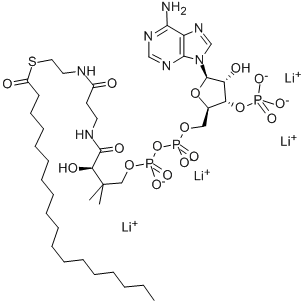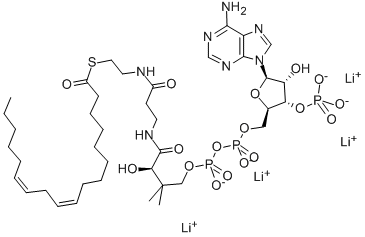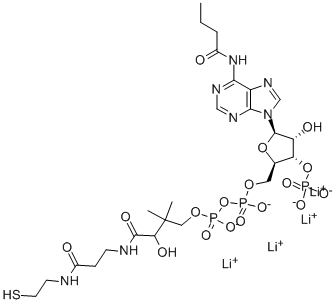COENZYME A TRILITHIUM SALT
Synonym(s):CoA Li3;Coenzyme A (lithium salt);Coenzyme A, Trilithium Salt - CAS 18439-24-2 - Calbiochem
- CAS NO.:18439-24-2
- Empirical Formula: C21H37LiN7O16P3S
- Molecular Weight: 775.48
- MDL number: MFCD00075848
- EINECS: 242-317-9
- SAFETY DATA SHEET (SDS)
- Update Date: 2023-04-23 13:52:06

What is COENZYME A TRILITHIUM SALT?
Chemical properties
Beige crystals
The Uses of COENZYME A TRILITHIUM SALT
Coenzyme A trilithium salt has been used:
- in standard curve generation in the kinetic assay of acetyltransferase Gcn5 acylation
- as a cofactor in JNADH and JNADPH production assay
- in the labeling of Alexa647 (AF647) probe
The Uses of COENZYME A TRILITHIUM SALT
A cofactor in enzymatic acetyl transfer reactions. It is the source of the phosphopantetheine group that is added as a prosthetic group to proteins such as acyl carrier protein and formyltetrahydrofol ate dehydrogenase
What are the applications of Application
Coenzyme A, Trilithium Salt is a cofactor in enzymatic acetyl transfer reactions
General Description
Coenzyme A (CoA) is synthesized from phosphopantothenate by the action of enzyme pantothenate kinase and is the master regulator.
Biochem/physiol Actions
Coenzyme A is a ubiquitous cofactor, synthesized from pantothenic acid through a ATP dependent reaction. It plays a vital role in tricarboxylic acid cycle, metabolism of short- and long-chain fatty acids. In addition, it also aids in synthesis of phospholipids and cell growth.
Properties of COENZYME A TRILITHIUM SALT
| Melting point: | >203°C (dec.) |
| storage temp. | -20°C |
| solubility | DMSO (Slightly, Heated), Methanol (Slightly, Sonicated), Water (Slightly) |
| form | Off-white solid |
| color | White to Off-White |
| Water Solubility | Soluble in water. |
| Sensitive | Hygroscopic |
| Stability: | Hygroscopic |
Safety information for COENZYME A TRILITHIUM SALT
| Signal word | Warning |
| Pictogram(s) |
 Exclamation Mark Irritant GHS07 |
| GHS Hazard Statements |
H302:Acute toxicity,oral H315:Skin corrosion/irritation H319:Serious eye damage/eye irritation H335:Specific target organ toxicity, single exposure;Respiratory tract irritation |
| Precautionary Statement Codes |
P280:Wear protective gloves/protective clothing/eye protection/face protection. P305+P351+P338:IF IN EYES: Rinse cautiously with water for several minutes. Remove contact lenses, if present and easy to do. Continuerinsing. |
Computed Descriptors for COENZYME A TRILITHIUM SALT
| InChIKey | QSCBPHBAFBVXRK-HJKJOZROSA-K |
New Products
(S)-3-Aminobutanenitrile hydrochloride 4-Methylphenylacetic acid N-Boc-D-alaninol N-BOC-D/L-ALANINOL Tert-butyl bis(2-chloroethyl)carbamate 3-Morpholino-1-(4-nitrophenyl)-5,6-dihydropyridin- 2(1H)-one Furan-2,5-Dicarboxylic Acid Tropic acid 1-Bromo-3,5-Di-Tert-Butylbenzene S-2-CHLORO PROPIONIC ACID ETHYL ISOCYANOACETATE 2-Bromo-1,3-Bis(Dimethylamino)Trimethinium Hexafluorophosphate 4-IODO BENZOIC ACID 3-NITRO-2-METHYL ANILINE 1-(2,4-DICHLOROPHENYL) ETHANAMINE (2-Hydroxyphenyl)acetonitrile 4-Bromopyrazole 2-(Cyanocyclohexyl)acetic acid 4-methoxy-3,5-dinitropyridine 1-(4-(aminomethyl)benzyl)urea hydrochloride 2-aminopropyl benzoate hydrochloride diethyl 2-(2-((tertbutoxycarbonyl)amino) ethyl)malonate tert-butyl 4- (ureidomethyl)benzylcarbamate Ethyl-2-chloro((4-methoxyphenyl)hydrazono)acetateRelated products of tetrahydrofuran








You may like
-
 Coenzyme A trilithium salt CAS 18439-24-2View Details
Coenzyme A trilithium salt CAS 18439-24-2View Details
18439-24-2 -
 Coenzyme A Trilithium Salt ex. Yeast extrapure CAS 18439-24-2View Details
Coenzyme A Trilithium Salt ex. Yeast extrapure CAS 18439-24-2View Details
18439-24-2 -
 Coenzyme A trilithium salt CAS 18439-24-2View Details
Coenzyme A trilithium salt CAS 18439-24-2View Details
18439-24-2 -
 Coenzyme A, Trilithium Salt CAS 18439-24-2View Details
Coenzyme A, Trilithium Salt CAS 18439-24-2View Details
18439-24-2 -
 Coenzyme A (Li salt) CAS 18439-24-2View Details
Coenzyme A (Li salt) CAS 18439-24-2View Details
18439-24-2 -
 1975-50-4 98%View Details
1975-50-4 98%View Details
1975-50-4 -
 14714-50-2 (2-Hydroxyphenyl)acetonitrile 98+View Details
14714-50-2 (2-Hydroxyphenyl)acetonitrile 98+View Details
14714-50-2 -
 118753-70-1 98+View Details
118753-70-1 98+View Details
118753-70-1